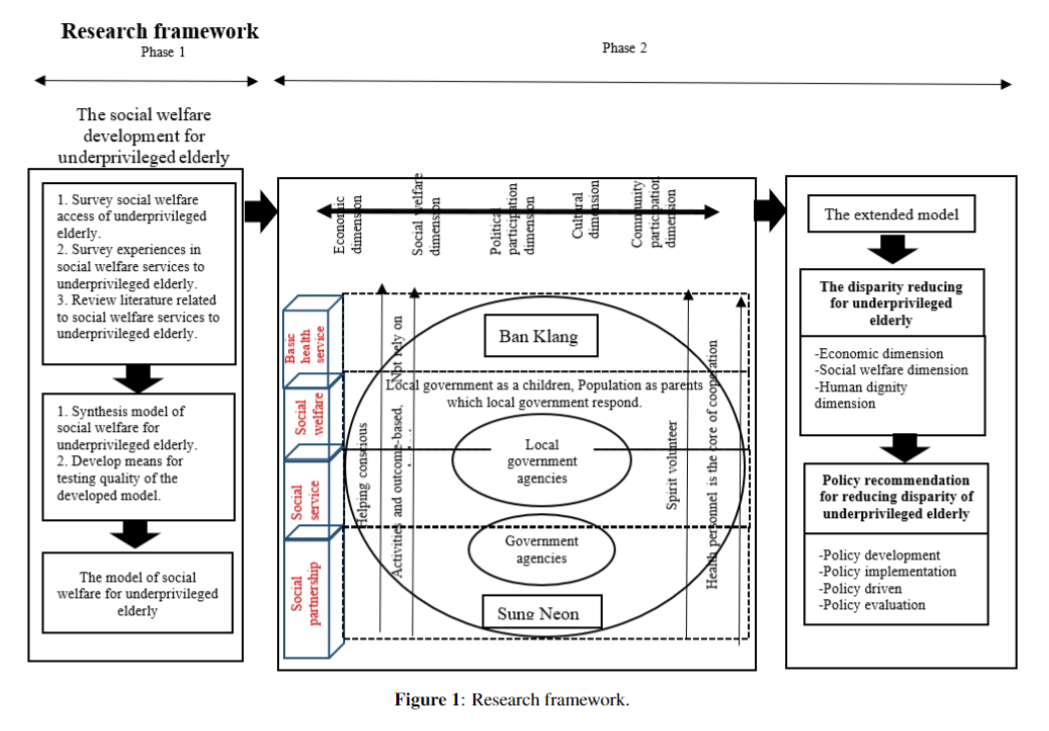Social welfare system development for disparity aging in order to decrease social inequality in sub-district rural areas, Thailand: From the preliminary model to the extended area
Main Article Content
Abstract
The preliminary model of social welfare system for social inequality reduction of the elderly has been applied in sub-district areas with the process of finding key factors leading to integrate activities related to sub-district plans. The new model is more prominent with respect to the dimensions of welfare and human dignity. The innovation results have mostly emerged from the spirit volunteers. Social inequality among disadvantaged seniors had decreased significantly. The research suggested that policy proposals based on empirical data should be used to specify the activity operations and a continuous learning exchange with the sub-district network involvement should be done.
Article Details

This work is licensed under a Creative Commons Attribution-NonCommercial-NoDerivatives 4.0 International License.
References
S. Manprasert, Impact of the elderly society connect to the Thai economy system. TRF policy brief, 2010.
National Statistical Office, Ministry of Information and Communication Technology, Survey of the Elderly Population in Thailand, Bangkok: Tex and Journal Public Company Limited, 2014.
V. Durongritthichai, et al., The development of a social welfare system for disadvantaged seniors to reduce social inequality: phase 2, Research report, 2018.
S. Sudsomboon, Social Welfare for Aging People in Thailand. Southern Technology Journal 7(1) (2014) 73082.
A. Zaidi, Life Cycle Transitions and Vulnerabilities in Old Age: A Review, UNDP Human Development Report Office, Occasional Paper, 2014.
P. Senanuch, T. Sunthornanantachai, The development of a social welfare system for
workforce seniors to reduce social inequality: phase 2, Research report, 2017.
S. Amornsiriphong, The development of a social welfare system for senior in special
economic zone to reduce social inequality: phase 2, Research report, 2017.
E. H. Bradley, M. Canavan, E. Rogan, K. Talbert-Slagle, C. Ndumele, L. Taylor, L. A. Curry, Variation in health outcomes: The role of spending on social services, public health, and health care, 2000-09, Health Affairs 35(5) (2016) 760-768.
T. S. Nanjundeswaraswamy, D. R. Swamy, Leadership styles, Advances In Management 7(2) (2014) 57-62.
S. Photchan, PDCA The heart of continuous improvement Review Paper: Leadership styles, https://www.ftpi.or.th/2015/2125, 2016.
E. M. Uslaner, M. Brown, Inequality, trust, and civic engagement, American politics research
https://www.russellsage.org/sites/all/files/u4/ Uslaner%20and%20Brown.pdf, 2003.
R. Oranratmanee, V. Sachakul, The use of public space for walking street market
in Thai urban cities, Journal of Mekong Societies 8(3) (2012) 121-142.
S. Karampour, M. Bojarpour, An implementation of TPB method for learning important factors influencing knowledge sharing, Management Science Letters (2012) 22293-2300.
T. H. Davenport, L. Prusak, Working knowledge: How organizations manage what they
know, ACM: Ubiquity - Working knowledge: How organizations management and forum, http://www.acm.org/ubiquity/book/ t_davenport_1.html, 2014.
S. Hansen, M. Avital, Share and share alike: The social and technological influences
in knowledge sharing behavior, Sprouts: Working papers on information systems 5(13) (2005).
T. Zhu, Z. Li, F. Luo, A Study on the influence of organizational climate on knowledge-sharing behavior in IT enterprises, Journal of Computers 5(4) (2010) 508-514.


